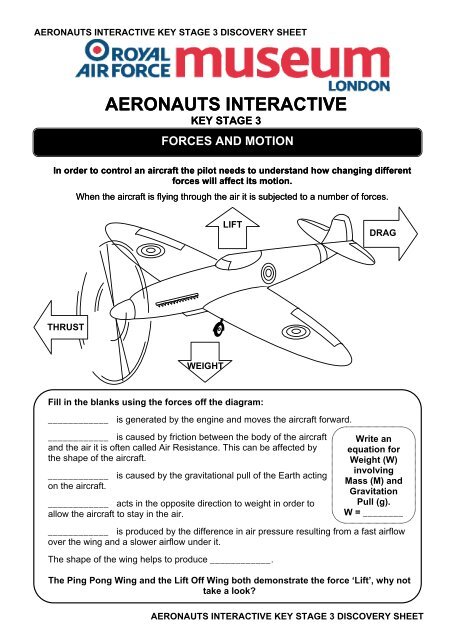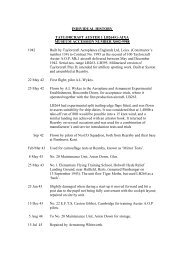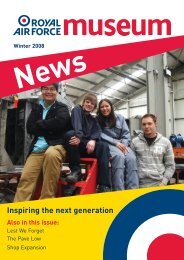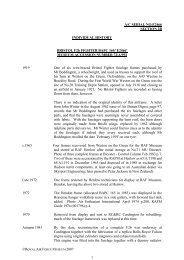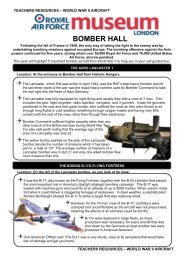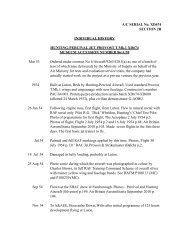Aeronauts Interactive Worksheet: Key Stage 3 - RAF Museum
Aeronauts Interactive Worksheet: Key Stage 3 - RAF Museum
Aeronauts Interactive Worksheet: Key Stage 3 - RAF Museum
You also want an ePaper? Increase the reach of your titles
YUMPU automatically turns print PDFs into web optimized ePapers that Google loves.
AERONAUTS INTERACTIVE KEY STAGE 3 DISCOVERY SHEET<br />
AERONAUTS INTERACTIVE<br />
KEY STAGE 3<br />
FORCES AND MOTION<br />
In order to control an aircraft the pilot needs to understand how changing different<br />
forces will affect its motion.<br />
When the aircraft is flying through the air it is subjected to a number of forces.<br />
LIFT<br />
DRAG<br />
THRUST<br />
WEIGHT<br />
Fill in the blanks using the forces off the diagram:<br />
____________ is generated by the engine and moves the aircraft forward.<br />
____________ is caused by friction between the body of the aircraft<br />
and the air it is often called Air Resistance. This can be affected by<br />
the shape of the aircraft.<br />
____________ is caused by the gravitational pull of the Earth acting<br />
on the aircraft.<br />
____________ acts in the opposite direction to weight in order to<br />
allow the aircraft to stay in the air.<br />
Write an<br />
equation for<br />
Weight (W)<br />
involving<br />
Mass (M) and<br />
Gravitation<br />
Pull (g).<br />
W = ________<br />
____________ is produced by the difference in air pressure resulting from a fast airflow<br />
over the wing and a slower airflow under it.<br />
The shape of the wing helps to produce ____________.<br />
The Ping Pong Wing and the Lift Off Wing both demonstrate the force ‘Lift’, why not<br />
take a look<br />
AERONAUTS INTERACTIVE KEY STAGE 3 DISCOVERY SHEET
AERONAUTS INTERACTIVE KEY STAGE 3 DISCOVERY SHEET<br />
When an aircraft is at rest (or travelling at constant velocity), the forces acting on it are<br />
equal. We say that the forces are balanced.<br />
We measure Force in Newtons (N)<br />
If the forces become unbalanced a change in the motion of the aircraft will occur. For<br />
example if there is an increase in drag (air resistance) then the aircraft will slow down.<br />
Try the following question.<br />
An aircraft has the following forces acting upon it:<br />
Lift = 500N Drag = 1000N Weight = 500N Thrust = 2000N<br />
What is the resultant force ………………………………<br />
Hint:<br />
How do we find the resultant force<br />
First work out the Vertical resultant force: Lift – Weight.<br />
Then work out the Horizontal resultant force: Thrust – Drag.<br />
In which direction will the aircraft be travelling ………………………………<br />
Find the exhibit Mass Attraction.<br />
Gently lift the figures away from the surfaces of each planet.<br />
Although the figures are the same size, the gravitational<br />
force affecting them differs with the size of the planet.<br />
Fill in the missing words to find the relationship between<br />
gravitational pull and the size of the planet;<br />
The ____________ the planet, the ____________ the pull.<br />
Remember the equation Weight (W) = Mass (M) x Gravity (g)<br />
Your Weight would be different on the Moon than on the Earth<br />
Find out your Mass in Kilograms on Earth using the Balance Beam Exhibit.<br />
Move the seat along the balance beam to find the point where you balance the engine.<br />
Check the scale on the side of the beam to find your mass.<br />
AERONAUTS INTERACTIVE KEY STAGE 3 DISCOVERY SHEET
AERONAUTS INTERACTIVE KEY STAGE 3 DISCOVERY SHEET<br />
Find the exhibit titled Air is a Drag.<br />
Make sure the paddles either side of the metal rod are horizontal.<br />
Turn the rod clockwise using the wheel. Now change the position of the paddles (to<br />
vertical) and turn once again. Notice how it feels different<br />
Is it harder or easier to turn when the paddles are going against the air stream<br />
………………………………<br />
What is the term used to describe this force. A_ _ R_ _ _ _ _ _ _ _<br />
If the frontal area of an aircraft is large then air resistance or drag will be increased<br />
because air resistance is proportional to surface area. The fastest aeroplanes are more<br />
streamlined.<br />
Which aircraft in the museum are very streamlined in shape Write your examples below.<br />
…………………………………………………....................................................<br />
When can an aircraft use air resistance to its advantage............................<br />
……………………………………………………………………………………….<br />
ENERGY RESOURCE AND ENERGY TRANSFER<br />
Fuels are materials which can be burned and will release usable amounts of energy. Aircraft<br />
use fuels made from oil and gas.<br />
These are fossil fuels. Fossil Fuels are non renewable.<br />
What do we mean by non renewable<br />
……………………………………………………………………………………………………………<br />
The engine on an aircraft is vital as it transforms fuel into the energy needed for<br />
the aircraft to fly.<br />
Fuel needs oxygen to burn (combust) and so it must be mixed with air.<br />
As the fuel is burned in the engine the chemical potential (or stored) energy is released.<br />
As well as light and heat energy, gases are produced when the fuel is burnt.<br />
It is these gases that propel a jet aircraft forwards by being usefully transferred into Kinetic<br />
(movement) energy.<br />
AERONAUTS INTERACTIVE KEY STAGE 3 DISCOVERY SHEET
AERONAUTS INTERACTIVE KEY STAGE 3 DISCOVERY SHEET<br />
Energy is measured in Joules. As the fuel burns the energy from the fuel is transformed<br />
into different forms. In the case being described: heat, light and movement.<br />
We must remember that no engine is 100% efficient some energy will inevitably be ‘lost’, for<br />
example as friction in the engine.<br />
Complete this sentence using the words from the box to<br />
explain the law of Conservation of Energy:<br />
Created<br />
Destroyed<br />
Transformed<br />
Energy can not be ____________ or ________ - it is ____________ into different forms.<br />
The Jet Engine<br />
The engine sucks in and then compresses air before combustion with the fuel takes<br />
place. Gases are then released, helping to generate thrust.<br />
COMPRESSOR<br />
COMBUSTION<br />
CHAMBER<br />
TURBINE<br />
FUEL<br />
FUEL<br />
HEAT+ LIGHT<br />
MOVEMENT<br />
AIR INTAKE<br />
FUEL BURNER<br />
Why not take a look at the Jet Engine on display on the ground floor in the<br />
Milestones of Flight building<br />
See if you can identify all of the areas from the diagram above.<br />
AERONAUTS INTERACTIVE KEY STAGE 3 DISCOVERY SHEET
AERONAUTS INTERACTIVE KEY STAGE 3 DISCOVERY SHEET<br />
Find the exhibit titled Jet Propelled. Read the instructions carefully.<br />
What happens to the chair as you throw the balls gently forward at the<br />
canvas holder<br />
……………………………………………………<br />
The energy that is created by throwing the balls is usefully transferred to<br />
thrust the chair in the opposite direction.<br />
An opposite reaction has thus occurred, according to Newton’s Third Law.<br />
This principle is seen when powering jet aeroplanes. The gases rushing<br />
out of the jet engine thrust the aeroplane forwards.<br />
Newton’s<br />
Third Law<br />
Every<br />
action has<br />
an equal<br />
and<br />
opposite<br />
reaction<br />
What happens to the chair if you throw the balls harder at the canvas holder<br />
……………………………………………………<br />
CLASSIFYING MATERIALS: GASES<br />
Find the Hot Air Balloon exhibit.<br />
Fill the balloon with hot air by pulling the ring and holding it down.<br />
Complete the following sentences using the words below:<br />
moving air descend rise cools<br />
faster colliding dense further<br />
In a gas the particles are much _______ apart<br />
than in solids and liquids. The particles are<br />
constantly ________ and ________with each<br />
other.<br />
When we heat the ________inside<br />
the balloon the particles move<br />
________and collide with the inside<br />
of the balloon,<br />
making it expand.<br />
Hot air is less ________ than cold air.<br />
Therefore the balloon will ________.<br />
As the balloon rises, the air inside ________ down.<br />
The balloon will ________.<br />
What type of energy transfer is described above;<br />
Conduction, Convection or Radiation<br />
AERONAUTS INTERACTIVE KEY STAGE 3 DISCOVERY SHEET
AERONAUTS INTERACTIVE KEY STAGE 3 DISCOVERY SHEET<br />
CIRCUITS<br />
In a circuit the battery provides energy. This is transferred around the circuit by the current.<br />
As the current flows through a component, electrical energy is transformed in different<br />
forms, e.g. heat and light.<br />
An electric current<br />
is the rate of flow<br />
of electric charge.<br />
In metal<br />
conductors<br />
negatively charged<br />
Electrons flow<br />
producing a<br />
current. Current is<br />
measured in<br />
Amps.<br />
+ -<br />
The battery<br />
provides the<br />
potential<br />
difference.<br />
Potential<br />
difference is<br />
measured in<br />
Volts and is<br />
commonly<br />
called Voltage.<br />
The more batteries there are in the circuit the greater the voltage will be. The greater the<br />
voltage the more energy is transformed by the bulbs and so the brighter they will be.<br />
A Series<br />
Circuit<br />
In a series circuit the current that<br />
flows is the same in all parts of the<br />
circuit, thus<br />
A 1<br />
V<br />
+ –<br />
A 2<br />
A 1 = A 2<br />
In a series circuit therefore, voltage<br />
is shared between the bulbs<br />
V<br />
V<br />
All<br />
components<br />
in one loop<br />
A Parallel<br />
Circuit<br />
V<br />
+ –<br />
A 1<br />
A 2<br />
V<br />
A 3<br />
V<br />
In a parallel circuit the current splits into<br />
different branches and then combines again.<br />
The current in each branch after the split is<br />
equal to the current before the split therefore<br />
A1 = A2 + A3.<br />
In parallel circuits the voltage across<br />
each bulb is the same as if it were the<br />
only bulb connected to the battery.<br />
Components<br />
are arranged<br />
in two or<br />
more loops<br />
AERONAUTS INTERACTIVE KEY STAGE 3 DISCOVERY SHEET
AERONAUTS INTERACTIVE KEY STAGE 3 DISCOVERY SHEET<br />
CIRCUITS<br />
The diagram below shows a Simple Series Circuit. Using the necessary components<br />
construct The diagram a circuit below to shows light the a Simple bulb. Series Circuit. Using the necessary components<br />
construct a circuit to light the bulb.<br />
Add an ammeter to you circuit. Note down the current.<br />
……………….Amps<br />
Add an ammeter to you circuit. Note down the<br />
current.<br />
……………….Amps<br />
Now place a second light bulb to your circuit. Does the light get brighter or dimmer<br />
…………………………………….<br />
Has the current increased or decreased Note the current now. …………Amps<br />
Now place a second light bulb to your circuit. Does the light get brighter or dimmer<br />
Add …………………………………….<br />
the switch to your circuit. What happens to the current when<br />
the switch is pressed down Look at the picture to help you.<br />
Has the current increased or decreased Note the current now. …………Amps<br />
………………………………………………………<br />
………………………………………………….<br />
Add the switch to your circuit. What happens to the current when<br />
the switch is pressed down Look at the picture to help you.<br />
……………………………………………………………………….…<br />
………………………………………………………………………….<br />
Try This<br />
At Home<br />
Can we find the Resistance of one bulb<br />
Ohms Law states that the current flowing through a conductor<br />
is proportional to the voltage across it.<br />
Therefore V = I x R,<br />
V = Voltage (measured in Volts)<br />
I = Current (measured in Amps)<br />
R = Resistance (measured in Ohms)<br />
If V = 6V and I = Current (the first reading from your ammeter) find R<br />
R = V ÷ I<br />
R =<br />
Ohms<br />
AERONAUTS INTERACTIVE KEY STAGE 3 DISCOVERY SHEET
AERONAUTS INTERACTIVE KEY STAGE 3 DISCOVERY SHEET<br />
Create a Parallel Circuit using the battery pack, two light bulbs, an ammeter and some<br />
wires. Draw your circuit using the following symbols.<br />
WIRE<br />
BULB<br />
AMMETER<br />
A<br />
BATTERY<br />
Note down the current. ………………………..<br />
How does the current in your Simple Series circuit differ from the current in your Parallel<br />
circuit<br />
…………………………………………………………………………………………<br />
LIGHT AND SOUND<br />
The light that we see around us is made up of all the different wavelengths of the colour<br />
spectrum but is known as white light because of its appearance.<br />
The way that this light appears to us can be changed using colour filters<br />
Find the Colour Vision exhibit<br />
Position the wheel to the white filter<br />
Look through the slots; what colour do the objects and the letters look in the white<br />
light<br />
What colour is the sunflower ..............................................................................................<br />
What colour is the Double Decker bus …………………………………………………………<br />
What colour is the ball ........................................................................................................<br />
An object reflects the wavelength of light related to the colour that we see and absorbs all<br />
the others.<br />
Now change the wheel to the red filter, this will only allow red light through; how does<br />
this change how things look<br />
What colour is the sunflower ..............................................................................................<br />
What colour is the Double Decker bus …………………………………………………………<br />
What colour is the ball ........................................................................................................<br />
Now try changing it to the wheel to the other colours in turn<br />
Does it change how you perceive the different colours of the objects or the letters<br />
AERONAUTS INTERACTIVE KEY STAGE 3 DISCOVERY SHEET


